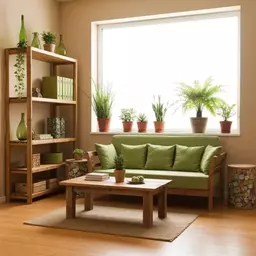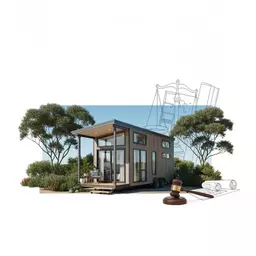Benefits of Adequate Insulation
- Lower Energy Bills
- Environmental Impact
- Increased Comfort
Get expert advice, innovative design ideas, and practical tips for your tiny home journey in Australia.
Posted on: 2025-10-28
By: Sophie Marchant
In the world of tiny living, every square foot counts, and so does every ounce of comfort. A well-insulated and properly ventilated home can transform a compact space into a cozy sanctuary, regardless of the outside conditions. The right choices can lead to not just a comfortable living environment, but also a sustainable lifestyle. Let's explore the essential elements that make tiny homes thrive!
Understanding the impact of insulation and ventilation is essential for maintaining comfort and energy efficiency in tiny homes. The following visual represents the benefits of proper insulation and ventilation strategies.
When it comes to tiny living, understanding insulation and ventilation is key to creating a comfortable and energy-efficient home. As someone who's deeply invested in the tiny house movement, I can tell you that proper insulation helps maintain a cozy atmosphere while reducing energy costs. Plus, effective ventilation ensures fresh air circulates, keeping your living space healthy and pleasant.
In this section, we'll explore the importance of insulation and ventilation in tiny homes, diving into the benefits they provide and how to implement effective strategies to maximize your living experience. Let's get started!
One of the most important aspects of tiny house construction is adequate insulation. It acts as a barrier against outside weather, keeping you warm in winter and cool in summer. Without proper insulation, you might find yourself battling high energy bills and discomfort as your heating or cooling systems work overtime. For more insights on efficient construction, consider selecting materials for tiny homes wisely.
Here are some key benefits of proper insulation for energy efficiency:
Now that we’ve touched on the importance of insulation, let’s dig a bit deeper into energy efficiency. Good insulation not only saves you money but also helps reduce your carbon footprint. Who wouldn’t want to live in a home that’s kind to the planet?
When considering insulation, think about materials that offer great thermal performance and align with your sustainability goals. This is where your personal preferences can really shine—choose options that resonate with your eco-friendly ethos!
Imagine curling up on a chilly evening, knowing your tiny home is warm and toasty thanks to effective insulation. With proper insulation, extreme weather conditions outside won’t dictate your comfort inside. You can create a cozy retreat regardless of the season!
Investing in high-quality insulation materials can provide lasting benefits. Think about the comfort of living in a space where the temperature is just right all year long—what a dream!
Next on our list is ventilation, which is just as crucial as insulation. In tiny homes, proper ventilation helps prevent moisture buildup and ensures that indoor air remains fresh and healthy. After all, nobody wants to deal with musty odors or air that feels stale!
Let’s explore the significance of effective ventilation and how it enhances your tiny living experience:
Moisture can be a tiny house owner's worst nightmare! It can lead to mold, mildew, and all sorts of unpleasant issues. That's why effective ventilation is essential for keeping your home safe and healthy.
By incorporating simple ventilation strategies, you can combat moisture buildup and protect your investment. Remember, a little bit of airflow goes a long way in safeguarding your tiny sanctuary!
Let’s talk about the air you breathe. The quality of indoor air significantly impacts your health and well-being. Effective ventilation allows you to enjoy fresh air while reducing the presence of irritants like dust and pet dander. For more tips on creating a healthy home, check out sustainable living in tiny homes.
Think of ventilation as your home's breathing mechanism; it keeps everything fresh and clean! By prioritizing air circulation, you're not just creating a comfortable environment but also fostering a healthy living space for you and your family.
Did you know? One of the best ways to enhance both insulation and ventilation in your tiny home is by incorporating natural building materials. Materials like straw bales or sheep's wool not only provide excellent insulation but also allow for better air circulation, helping you achieve a sustainable and comfortable living environment.
When it comes to tiny houses, understanding the impact of different climate types is crucial for creating a comfortable living space. Whether you're in a hot, humid environment or experiencing cold winters, adapting your insulation and ventilation strategy can make all the difference. Here’s how to tailor your approach based on your local climate.
Consider the unique demands of your surroundings. For example, hot climates require a focus on keeping the interior cool, while cold areas might prioritize heat retention. Ignoring these factors can lead to discomfort and higher energy costs. As the founder of The Tiny Living Guide, I encourage you to think about how local climate plays a role in your tiny home design.
In hot climates, it’s essential to keep your tiny home cool and well-ventilated. Here are some strategies to consider:
By implementing these techniques, you can enjoy a more comfortable living environment and reduce your reliance on air conditioning. It’s all about creating a cool sanctuary in your tiny home!
On the flip side, if you live in a cold and humid climate, your approach must shift to retain warmth and prevent moisture buildup. Here are some recommendations:
These adjustments will help maintain a warm and dry atmosphere, ensuring that your tiny home feels cozy all year round. I’ve seen many tiny home enthusiasts successfully adapt their spaces to combat the elements. If you're planning your own tiny home, explore some tiny house design ideas simplified to get started.
Ultimately, considering your local climate is vital for choosing the right insulation and ventilation solutions. Take the following steps:
By being proactive and informed, you'll be better equipped to create a sustainable and efficient tiny home that thrives in its environment. A personalized approach is key to achieving that balance!
As you navigate the world of tiny house insulation and ventilation, you might have some questions. Here are a few common inquiries I often hear:
Best practices include selecting insulation materials that suit your climate, ensuring proper installation, and regularly checking for any signs of wear or damage.
Effective ventilation can be achieved by combining natural airflow techniques, like opening windows, with mechanical systems such as exhaust fans or HRV units. This will improve air quality significantly!
To enhance energy efficiency, focus on high-quality insulation, proper sealing of all gaps, energy-efficient windows and doors, and incorporating passive design strategies that leverage natural light and airflow. Regularly maintaining your heating and cooling systems also helps.
Common challenges include limited space for thick insulation, managing moisture in compact areas, and balancing airflow without losing too much heat or cool air. Addressing these often requires creative solutions and careful planning.
Start by familiarizing yourself with local building codes. It’s crucial to understand what’s required for your specific region, and I recommend connecting with local building officials or tiny home communities for guidance.
To summarize, understanding insulation and ventilation is essential for creating a cozy and energy-efficient tiny home. By tailoring your strategies to your local climate, you can improve comfort and sustainability.
Every choice you make in your tiny home contributes to a more sustainable lifestyle. By investing in high-quality insulation and effective ventilation, you’re not just enhancing your comfort; you’re also making a positive impact on the environment.
As you move forward with your tiny home journey, consider exploring products and services specifically designed for insulation and ventilation. Here are some action steps:
Remember, the tiny living community is here to support you! Let’s create spaces that reflect our values and aspirations. What’s your next step in your tiny home journey? For more detailed guidance, consider exploring this comprehensive tiny house insulation guide.
Here is a quick recap of the important points discussed in the article:

 What if your small living space could also be a sanctuary for the planet? Embracing sustainability n
What if your small living space could also be a sanctuary for the planet? Embracing sustainability n
 As the tiny home movement gains momentum in Australia, the legal landscape can feel daunting. Howeve
As the tiny home movement gains momentum in Australia, the legal landscape can feel daunting. Howeve
 Did you know that zoning laws can significantly impact the feasibility of sustainable housing initia
Did you know that zoning laws can significantly impact the feasibility of sustainable housing initia